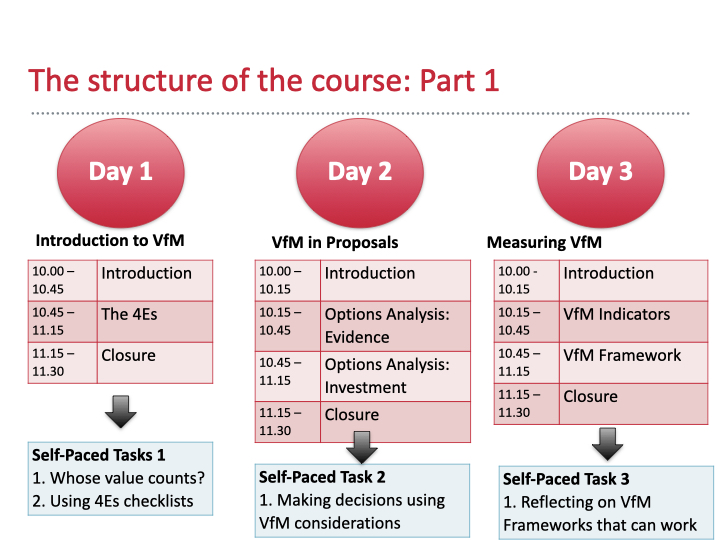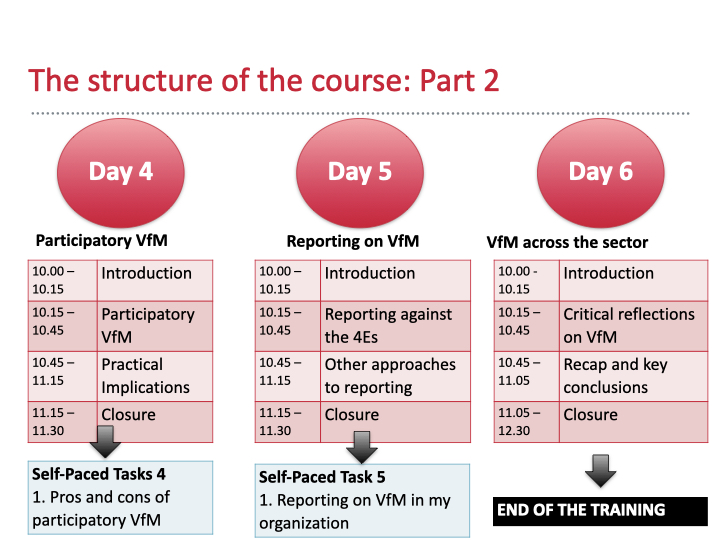
Learning and Change has been sub-contracted again in 2022 by Bond to deliver its online VfM training ‘Putting Value for Money into Practice’, an introductory training on Value for Money (VfM) aimed at equipping participants with tools and methods to integrate VfM in the work that they do at proposal stage, during implementation and when reporting. It is designed to be interactive and fun, using a case study to help trainees practise the use of the tools.
Structure of the training
The VfM training is structured in six 90min sessions (usually two sessions per week) plus an introductory Meet and Greet session.
In the first session we introduce the concept of VfM, its definition and the most common framework used to assess it, also known as the 4Es Framework.
In the second session, we focus on the proposal stage and participants practise the use of some tools to analyse the VfM of a proposal.
Session 3 tends to be of great interest as it concentrates on VfM Frameworks and provides some tips and examples on how a programme or organization may go about designing VfM indicators, criteria or standards.
The fourth session introduces tools on how to assess VfM during the implementation of a programme, using participatory methods (see the Toolkit for this here).
Day 5 focusses on reporting and provides two approaches that can be used to report on VfM, providing guidelines on what to include.
Finally, the last session aims at critically reflecting on VfM, drawing out some elements from the literature and how it has been used across the sector, to discuss what this may mean for participants and their organizations.
In addition, participants are asked to complete a series of self-paced tasks in between the sessions to consolidate their learning and further practise the use of the tools.

VfM training Part 1

VfM training Part 2
Why is this VfM training useful
Our Director, Francesca, has been delivering this training since 2015 and the course has been regularly updated to incorporate new findings and experiences across the sector. Participants find it useful because it is very hands-on, it is not theoretical and concentrates on how VfM can be used and integrated in a meaningful way in an organization’s ways of working.
Taking the VfM training online
With the Covid-19 pandemic, the training, originally designed to be 1-day face-to-face training, was readapted to the online environment and uses a series of tools, which participants usually find quite user-friendly, including Jamboard, Google Docs and Slides and a purposely built platform that enables participants to easily follow the flow of the course and access relevant resources.
Delivering the course online has also meant that the range of participants has changed considerably. When it was delivered face-to-face in London the audience used to be mostly UK-based staff of international NGOs, whereas at the moment it has attracted participant from multiple countries from both the global North and South, enabling networking and the sharing of a significant variety of experiences.
Participants feedback
Here are some comments received by participants:
I liked the variety of tech tools and exercises combined with info. It’s by far the most interactive online course I have experienced.
I felt technically it worked very well, the online learning platform is set up so well and is easy to use. I really like that we can access it after the course too. It also worked well because the trainer (Francesca) provided lots of opportunity to be interactive and was very engaging. I would always prefer to conduct training in person, but this was the next best thing!
Love the dynamic and mixed learning approach with a combination of written tasks, group work, reading, presentations by Francesca, all very interactive and useful.
I liked how the live sessions were spread out and their duration. It made attending them during working hours feasible.
Self-paced tasks forced me to think about VfM in “my” own context. Group work gave me knowledge and inspiration from the other course participants.
I found all the aspects quite helpful, but two in particular were Measuring VfM/VfM frameworks, and the reporting (for more immediate application)
Although I am still trying to understand how it works within my organisation, the participatory approach to VfM was great for highlighting how VfM can be used to understand value from the beneficiaries perspective (I look forward to seeing how I can apply this).
Tailored VfM trainings
This training has also been adapted and tailored to specific organizations that requested in-house trainings addressed to their staff. For this, a new case study is developed using the organization’s material and the sessions are adapted to respond to what the organization needs to focus on. Have a look at this blog on how we readapted it to a VfM Training of Trainers (ToT) for the World Health Organization (WHO).
Join us to improve your impact and make a difference in the lives of the people you work with.
Learning and Change


Social Contact